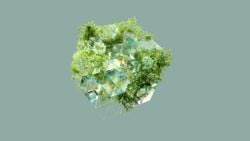The Astonishing Intersection of Ecology and Technology: How Modern Innovations are Revolutionizing Our Understanding of Nature

- Blog Yazısı
In a groundbreaking confluence of ecology and technology, recent studies have highlighted astonishing advancements in our understanding of nature through cutting-edge innovations. This harmonious marriage of conservation science and modern technology sets the stage for transformative impacts on biodiversity, climate change, and ecological research methodologies.
The field of ecology is evolving at a pace that mirrors technological advancements. Karl Marx’s notion that human society can alter natural ecosystems vastly underestimated the extent to which modern technology would integrate with stability, preservation, and restoration practices.
Take, for example, the use of drones in ecological monitoring. In the past, tracking wildlife and understanding ecosystems required exhaustive human labor and invasive methods. Today, drones equipped with high-resolution cameras and sensors can collect data from otherwise inaccessible areas. This allows ecologists to monitor wildlife populations, vegetation health, and even detect illegal activities like poaching, with unprecedented efficiency and minimal disturbance to the environment.
Additionally, advancements in artificial intelligence (AI) have vastly enhanced data analysis capabilities. AI algorithms, for instance, can analyze satellite images to track deforestation in real-time. These algorithms can differentiate between natural forest regeneration and human encroachments, providing essential data for policymakers to create more effective conservation strategies. AI-driven models can also predict the potential impacts of climate change on various species, helping in the design of targeted conservation measures.
Moreover, the integration of internet-of-things (IoT) devices in ecological research is another innovation transforming the field. IoT sensors, placed in remote habitats, can continuously collect environmental data such as temperature, humidity, and soil moisture levels. These interconnected sensors transmit data to a centralized system where it can be analyzed to detect environmental changes and trends over time. For instance, IoT devices have been employed in precision agriculture to optimize water usage and reduce pesticide dependence, promoting both sustainability and productivity.
In-depth analysis of these technological applications reveals their profound implications on various stakeholders. Policymakers, equipped with precise and up-to-date data, can develop more informed and effective environmental regulations. Conservationists can employ these technologies to better safeguard endangered species and critical habitats. For industry professionals, especially those in agriculture and fisheries, these tools offer pathways to enhance productivity while minimizing ecological footprints.
Yet, despite these promising advancements, several challenges persist. Ethical concerns regarding data privacy and the potential misuse of AI and IoT data loom large. The accuracy and reliability of AI predictions are contingent on the quality of input data, which can often be biased or incomplete. Additionally, the deployment of high-tech solutions sometimes risks diverting attention and resources away from traditional, community-based conservation methods that have stood the test of time.
Addressing these limitations requires a multifaceted approach. Continuous refinement of AI models based on diverse and high-quality data sets is imperative. As technology advances, it is crucial to implement stringent data privacy regulations to prevent misuse. Furthermore, integrating these technologies with traditional conservation practices can create a robust, holistic approach to ecological preservation.
Looking ahead, the potential for further advancements in this field is immense. Future research might focus on developing more sophisticated AI algorithms capable of synthesizing vast arrays of ecological data for comprehensive insights. Innovations like bioacoustic monitoring, which uses sound to track wildlife and habitat conditions, may find broader applications. Additionally, the development of sustainable technologies, such as solar-powered IoT devices, could mitigate the environmental impact of using technology in ecological research.
To catalyze these advancements, increased investment in technology development and interdisciplinary collaboration between ecologists, technologists, and policymakers is essential. By fostering an environment where technology and ecology coalesce seamlessly, we pave the way for a future where conservation efforts are more effective, efficient, and inclusive.
- 0
- 0
- 0
- 0
- 0
- 0
- 0
- 0
- 0
- 0
- 0
- 0
Evrim Ağacı'na her ay sadece 1 kahve ısmarlayarak destek olmak ister misiniz?
Şu iki siteden birini kullanarak şimdi destek olabilirsiniz:
kreosus.com/evrimagaci | patreon.com/evrimagaci
Çıktı Bilgisi: Bu sayfa, Evrim Ağacı yazdırma aracı kullanılarak 05/12/2025 05:31:23 tarihinde oluşturulmuştur. Evrim Ağacı'ndaki içeriklerin tamamı, birden fazla editör tarafından, durmaksızın elden geçirilmekte, güncellenmekte ve geliştirilmektedir. Dolayısıyla bu çıktının alındığı tarihten sonra yapılan güncellemeleri görmek ve bu içeriğin en güncel halini okumak için lütfen şu adrese gidiniz: https://evrimagaci.org/s/17712
İçerik Kullanım İzinleri: Evrim Ağacı'ndaki yazılı içerikler orijinallerine hiçbir şekilde dokunulmadığı müddetçe izin alınmaksızın paylaşılabilir, kopyalanabilir, yapıştırılabilir, çoğaltılabilir, basılabilir, dağıtılabilir, yayılabilir, alıntılanabilir. Ancak bu içeriklerin hiçbiri izin alınmaksızın değiştirilemez ve değiştirilmiş halleri Evrim Ağacı'na aitmiş gibi sunulamaz. Benzer şekilde, içeriklerin hiçbiri, söz konusu içeriğin açıkça belirtilmiş yazarlarından ve Evrim Ağacı'ndan başkasına aitmiş gibi sunulamaz. Bu sayfa izin alınmaksızın düzenlenemez, Evrim Ağacı logosu, yazar/editör bilgileri ve içeriğin diğer kısımları izin alınmaksızın değiştirilemez veya kaldırılamaz.







